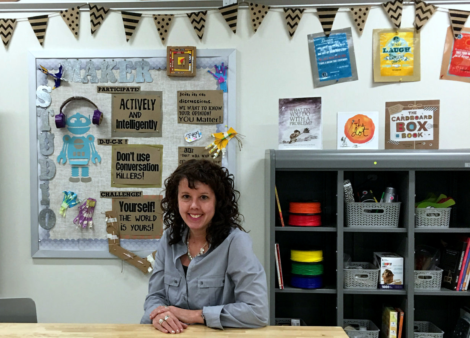
Formative Assessment with CBE of the Month Ricardo Vela
Posted by cemignano on
We’re excited to introduce you to April’s Certified BrainPOP Educator of the Month, Ricardo Vela! Ricardo teaches US History and is part of the White Plains Public School District in White Plains, NY. Read on to learn more about Ricardo’s experience as a CBE and how the CBE program has impacted him as an educator.
What grade(s) do you teach? Subject area?
7th Grade US History: 1 co-teaching section, 2 bilingual (Spanish) sections, and 2 “regular” sections.
How long have you been teaching?
I am in my 14th year of teaching and my 11th year in White Plains, NY.
What inspired you to go into education?
My parents were both educators at various points in their lives so teaching seemed like a logical and natural fit for me. Having obtained a minor in history with some amazing college professors often made me think about all the boring history teachers I had growing up; I felt I could actually make learning history fun AND educational. I applied and got accepted into graduate school to become a 7-12 Social Studies teacher and the rest is, well, you know…. (Oh, I also wanted summers off, but the jokes on me, I haven’t had a summer off since becoming a teacher thanks to teaching summer school!)
Which CBE class were you a part of? What do you like about being a CBE?
I was part of one of the first CBE classes. I remember going to BrainPOP headquarters in downtown NYC to receive my initial training, that was the highlight of the year for me. There are so many things I enjoy about being a CBE… being part of a network of amazing educators from across the country who inspire me each and every day, being part of the CBE community and helping others when they are learning to navigate and use BrainPOP, leading workshops and teaching educators and administrators about how BP can enhance student learning.
What is one of the most memorable projects you’ve done with your class using BrainPOP resources?
I was selected to participate in the A-GAMES study, a collaboration between BrainPOP, NYU and the University of Michigan’s School of Education. That is when I really immersed myself in the world of BrainPOP. At the time, I was teaching a law class to 7th graders and I used the “Do I Have a Right?” game in the study. My students learned about the rights enshrined in the Constitution through the Bill of Rights and various other Constitutional Amendments. After a couple of weeks of instruction, I had students play the game as a way to assess their understanding and the results were amazing. As students completed each round of play, I was able to see a detailed report listing exactly which Amendments they mastered and which needed to be reviewed. I was able to provide students with additional instruction tailored to their needs through viewing BP videos related to those specific Amendments where they had not achieved mastery and then have them play the game again. Without fail, ALL the students were able to master ALL of the Amendments in a fun and engaging way.
How has BrainPOP impacted a specific student (or group of students)?
I see the impact of BrainPOP on a “type” of student, one I would call the reluctant learner. I have often found that students who are less engaged in the traditional classroom setting become active participants when they watch a BrainPOP video and say, complete a Make-A-Map activity or play a game like Sortify. These types of interactive activities are not only more “fun” but allow those students to take risks that they might not be willing to take in front of their peers. Furthermore, by using the features in My BrainPOP, I’m able to provide them with immediate and meaningful feedback that they can then apply and use to further their understanding.
How has becoming a CBE impacted you?
The biggest impact that being a CBE has had on me is in my role as a teacher trainer, providing professional development opportunities for fellow teachers in my school, district and state. Before becoming a CBE, I was a typical teacher who came to work, did his thing and went home to grade and plan. Providing PD as a part of the CBE certification requirements was my first exposure to training other teachers; my first time instructing teachers instead of solely students. Since becoming a CBE I have led workshops at my school, at a regional technology conference, and most recently during my presentation of “Digital Games and the Dual Language/Bilingual Classroom: Using Games to Enhance Second Language Acquisition” at the New York State Association of Bilingual Educators’ 2017 Conference. During my presentation I was able to discuss the benefits of using BrainPOP in a bilingual/dual language setting. I am now planning on submitting a similar proposal to “La Cosecha”, the national Dual Language conference held annually in New Mexico. I would never have thought about doing anything like this had it not been for my work as a CBE.
What are you most passionate about when it comes to education, technology, and your approaches to teaching?
As a child of the 80s and early 90s, I’m part of the first generation where owning a personal computer became a “thing.” I took my first computer programming class in 4th grade in 1983! At home my parents bought us an IBM PS/2 Model 25 and I would stay up all night playing … formatting the hard drive and reinstalling DOS and generally “breaking and fixing” the computer. LOL! As such, I have always had a deep interest in technology and since becoming a teacher, have sought ways to integrate technology into my classroom. I am privileged to be in a district that strongly supports the use of technology in the classroom. Next year, we are beginning the process of becoming a 1:1 district where every student will receive an iPad. As a result, integrating technology into my daily lessons is not just an option, but an integral part of my teaching.
I see my role as an educator as being one who will prepare students to enter the 21st century labor force and be active, engaged citizens. Despite being a history teacher, in the end, I don’t really care if my students remember when the Civil War was fought or that Alexander Hamilton’s and Thomas Jefferson’s disputes over the role of the federal government is what led to the creation of the first political parties. What I do care about is providing students with the opportunities to learn the skills they will need to be successful and productive members of our society. I believe the only way to do that is by infusing technology into the classroom on every level.
What’s on your BrainPOP wish list?
Oh, this is easy… Every BrainPOP video translated into Spanish. As a bilingual teacher, my greatest challenge with using BrainPOP is reaching those students for whom English is a second language. I have many students who come to us only knowing Spanish. And while I teach their classes in Spanish and am able to provide them with lots of translated resources, there are very few technological resources available to them in their native tongue. BrainPOP en Español is a great resource for them and for me, but in order to provide them with the same experiences as the students in my “regular” classes, I need more videos in Spanish!
At the same time however, not having a lot of the BrainPOP movies in Spanish has forced me to be more creative in my approach to using English-language BP movies with Entering and Emergent ELLs. I have slowly become more adept at integrating translanguaging strategies with BrainPOP movies and activities in order to help second language learners be more successful. (With that in mind, stay tuned for my forthcoming blog: Integrating Translanguaging Strategies with BrainPOP in the Bilingual Classroom!)














